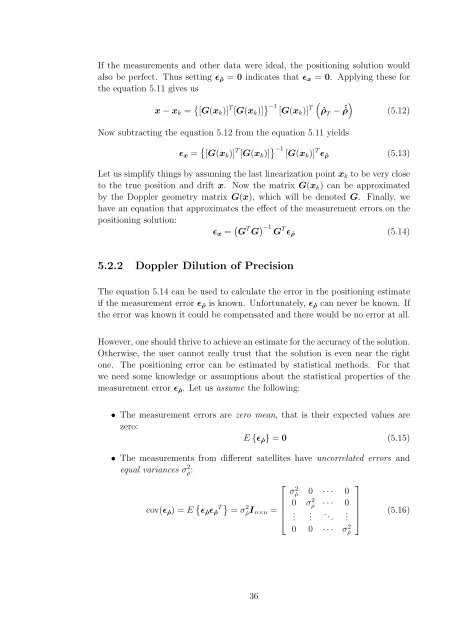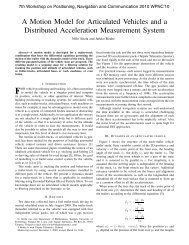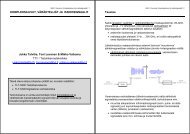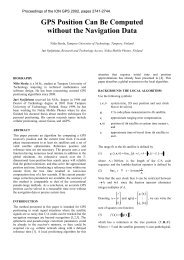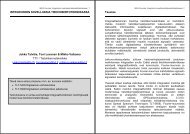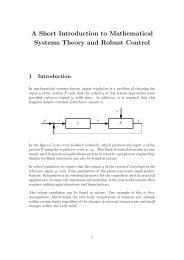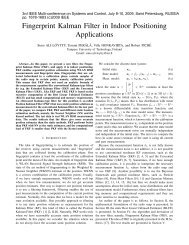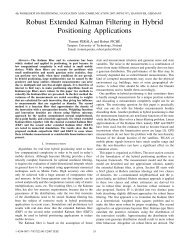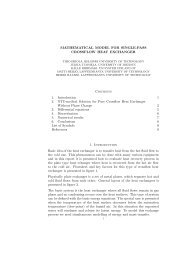Antti Lehtinen Doppler Positioning with GPS - Matematiikan laitos
Antti Lehtinen Doppler Positioning with GPS - Matematiikan laitos
Antti Lehtinen Doppler Positioning with GPS - Matematiikan laitos
Create successful ePaper yourself
Turn your PDF publications into a flip-book with our unique Google optimized e-Paper software.
If the measurements and other data were ideal, the positioningsolution would<br />
also be perfect. Thus setting ɛ ˙ρ = 0 indicates that ɛx = 0. Applyingthese for<br />
the equation 5.11 gives us<br />
x − xk = [G(xk)] T [G(xk)] −1 [G(xk)] T<br />
<br />
˙ρ T − ˆ˙ρ (5.12)<br />
Now subtractingthe equation 5.12 from the equation 5.11 yields<br />
ɛx = [G(xk)] T [G(xk)] −1 [G(xk)] T ɛ ˙ρ<br />
(5.13)<br />
Let us simplify things by assuming the last linearization point xk to be very close<br />
to the true position and drift x. Now the matrix G(xk) can be approximated<br />
by the <strong>Doppler</strong> geometry matrix G(x), which will be denoted G. Finally, we<br />
have an equation that approximates the effect of the measurement errors on the<br />
positioningsolution:<br />
ɛx = G T G −1 T<br />
G ɛ ˙ρ<br />
(5.14)<br />
5.2.2 <strong>Doppler</strong> Dilution of Precision<br />
The equation 5.14 can be used to calculate the error in the positioningestimate<br />
if the measurement error ɛ ˙ρ is known. Unfortunately, ɛ ˙ρ can never be known. If<br />
the error was known it could be compensated and there would be no error at all.<br />
However, one should thrive to achieve an estimate for the accuracy of the solution.<br />
Otherwise, the user cannot really trust that the solution is even near the right<br />
one. The positioningerror can be estimated by statistical methods. For that<br />
we need some knowledge or assumptions about the statistical properties of the<br />
measurement error ɛ ˙ρ. Letusassume the following:<br />
• The measurement errors are zero mean, that is their expected values are<br />
zero:<br />
E {ɛ ˙ρ} = 0 (5.15)<br />
• The measurements from different satellites have uncorrelated errors and<br />
equal variances σ 2 ˙ρ:<br />
cov(ɛ ˙ρ) =E ɛ ˙ρɛ ˙ρ T = σ 2 ⎢<br />
˙ρIn×n = ⎢<br />
⎣<br />
36<br />
⎡<br />
σ2 ˙ρ 0 ··· 0<br />
0 σ2 ˙ρ ··· 0<br />
.<br />
.<br />
...<br />
0 0 ··· σ 2 ˙ρ<br />
.<br />
⎤<br />
⎥<br />
⎦<br />
(5.16)


